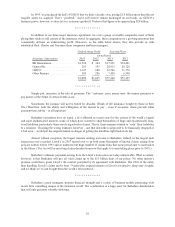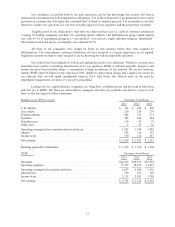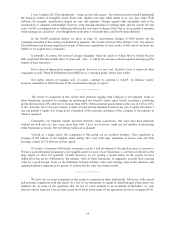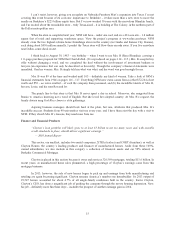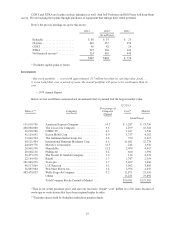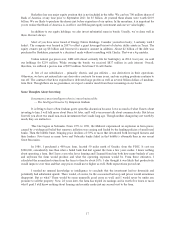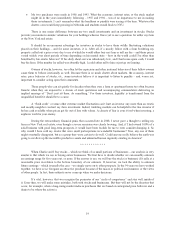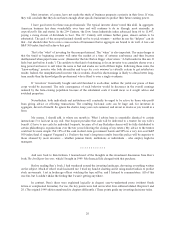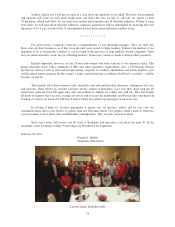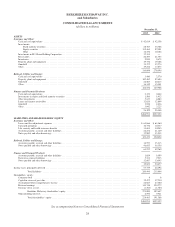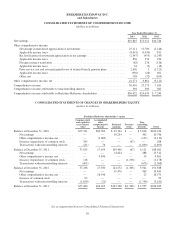Berkshire Hathaway 2013 Annual Report Download - page 22
Download and view the complete annual report
Please find page 22 of the 2013 Berkshire Hathaway annual report below. You can navigate through the pages in the report by either clicking on the pages listed below, or by using the keyword search tool below to find specific information within the annual report.Most investors, of course, have not made the study of business prospects a priority in their lives. If wise,
they will conclude that they do not know enough about specific businesses to predict their future earning power.
I have good news for these non-professionals: The typical investor doesn’t need this skill. In aggregate,
American business has done wonderfully over time and will continue to do so (though, most assuredly, in
unpredictable fits and starts). In the 20th Century, the Dow Jones Industrials index advanced from 66 to 11,497,
paying a rising stream of dividends to boot. The 21st Century will witness further gains, almost certain to be
substantial. The goal of the non-professional should not be to pick winners – neither he nor his “helpers” can do
that – but should rather be to own a cross-section of businesses that in aggregate are bound to do well. A low-cost
S&P 500 index fund will achieve this goal.
That’s the “what” of investing for the non-professional. The “when” is also important. The main danger is
that the timid or beginning investor will enter the market at a time of extreme exuberance and then become
disillusioned when paper losses occur. (Remember the late Barton Biggs’ observation: “A bull market is like sex. It
feels best just before it ends.”) The antidote to that kind of mistiming is for an investor to accumulate shares over a
long period and never to sell when the news is bad and stocks are well off their highs. Following those rules, the
“know-nothing” investor who both diversifies and keeps his costs minimal is virtually certain to get satisfactory
results. Indeed, the unsophisticated investor who is realistic about his shortcomings is likely to obtain better long-
term results than the knowledgeable professional who is blind to even a single weakness.
If “investors” frenetically bought and sold farmland to each other, neither the yields nor prices of their
crops would be increased. The only consequence of such behavior would be decreases in the overall earnings
realized by the farm-owning population because of the substantial costs it would incur as it sought advice and
switched properties.
Nevertheless, both individuals and institutions will constantly be urged to be active by those who profit
from giving advice or effecting transactions. The resulting frictional costs can be huge and, for investors in
aggregate, devoid of benefit. So ignore the chatter, keep your costs minimal, and invest in stocks as you would in a
farm.
My money, I should add, is where my mouth is: What I advise here is essentially identical to certain
instructions I’ve laid out in my will. One bequest provides that cash will be delivered to a trustee for my wife’s
benefit. (I have to use cash for individual bequests, because all of my Berkshire shares will be fully distributed to
certain philanthropic organizations over the ten years following the closing of my estate.) My advice to the trustee
could not be more simple: Put 10% of the cash in short-term government bonds and 90% in a very low-cost S&P
500 index fund. (I suggest Vanguard’s.) I believe the trust’s long-term results from this policy will be superior to
those attained by most investors – whether pension funds, institutions or individuals – who employ high-fee
managers.
************
And now back to Ben Graham. I learned most of the thoughts in this investment discussion from Ben’s
book The Intelligent Investor, which I bought in 1949. My financial life changed with that purchase.
Before reading Ben’s book, I had wandered around the investing landscape, devouring everything written
on the subject. Much of what I read fascinated me: I tried my hand at charting and at using market indicia to predict
stock movements. I sat in brokerage offices watching the tape roll by, and I listened to commentators. All of this
was fun, but I couldn’t shake the feeling that I wasn’t getting anywhere.
In contrast, Ben’s ideas were explained logically in elegant, easy-to-understand prose (without Greek
letters or complicated formulas). For me, the key points were laid out in what later editions labeled Chapters 8 and
20. (The original 1949 edition numbered its chapters differently.) These points guide my investing decisions today.
20


